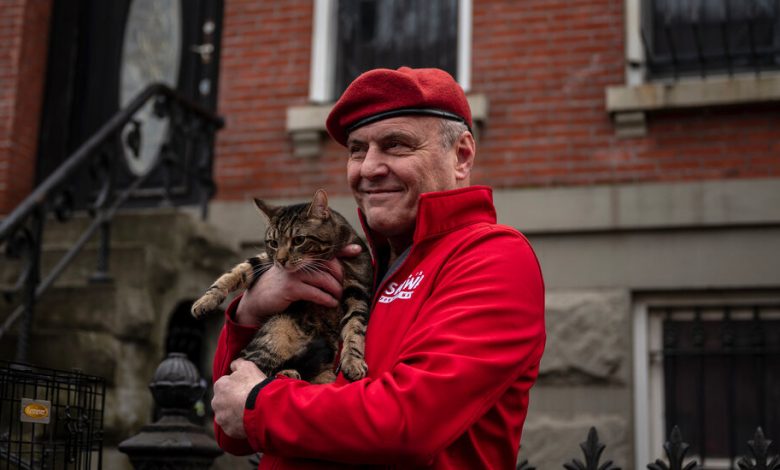Mayor Adams Has Rats. Curtis Sliwa Has Cats. What Could Go Wrong?

In front of a red brick Brooklyn rowhouse, it was clear that Mayor Eric Adams’s ongoing war on rats had reached another level of absurdity.
In the middle of a busy New York City workday, a dozen or so reporters had gathered, along with at least eight police officers, three Guardian Angels in red berets (including Curtis Sliwa, who lost to Mr. Adams in the 2021 mayoral election), two charismatic cats in a cage, and one very dead rat, plastered on Lafayette Avenue, its hairless tail still largely intact.
“The most photographed dead rat in New York City history,” said one onlooker, Michael Daly, a columnist with The Daily Beast.
The rowhouse is owned by none other than Mayor Adams, who has once again been fined for failing to control rats at his four-unit apartment house in the Bedford-Stuyvesant neighborhood of Brooklyn.
One year into his tenure, Mr. Adams has no shortage of monumental problems on his plate, among them the economic revival of the nation’s financial capital and record levels of homelessness.
But one comparatively picayune problem continues to bedevil him, both professionally and personally: the humble, and prolific, brown rat.
On Dec. 7, the day after Mr. Adams successfully challenged an earlier rat-related summons at his Brooklyn property, the health department he controls issued two new summonses to the mayor, both for failing to control rats. The new summonses, first reported by The New York Post, carry up to $1,200 in fines in total for Mr. Adams. Both were issued by the same health inspector who levied the initial summons. (The inspector could not be reached for comment.)
And, like the last time, Mr. Adams again said he would fight the fines in the city’s administrative tribunal, which he also effectively controls.
“I’m going to do like every New Yorker, I’m going to go back to court, show all my evidence,” Mr. Adams said during an unrelated news conference on Wednesday. “We have a rat problem in the city. I mean, who are we kidding?”
Mr. Adams’s history with rats is long and complicated. He claims to be terrified of them, but also said his childhood home was so overrun by rats that he and his siblings adopted one as a pet. As Brooklyn borough president, he angered animal rights advocates — who once applauded him for extolling the benefits of veganism — by publicly showcasing a rat drowning device during a demonstration that involved ladling dead rats out of a vat.
This year, his administration announced that it would hire a director of rodent mitigation with the “drive, determination and killer instinct needed to fight the real enemy: New York City’s relentless rat population.” The hiring process is still underway, according to the mayor’s spokesman, Fabien Levy.
Mr. Sliwa, the founder of the Guardian Angels who ran against Mr. Adams for mayor in 2021, has said he would be happy to offer his services. And for starters, he offered to help the mayor with his personal rat problem by deploying an army of feral cats.
“He’s tried everything,” said Mr. Sliwa, as his wife, Nancy, petted Tiny, a white-nosed tuxedo cat, and Thor, a tabby, through the bars of their cages. “But it’s time that we revert to the best measure that’s ever worked. And that’s cats.”
The Sliwas have opened their home to rescue cats; 16 cats share their home, Ms. Sliwa said Wednesday, including Tiny and Thor.
Mr. Sliwa said the two animals were slated to be euthanized when they were rescued. And he argued that instead of killing cats, the city should use them to keep rats at bay. Plenty of middle-aged women already care for feral cat colonies, he said, and the women could be enlisted to expand their operations.
And he suggested that if Mr. Adams were willing, Mr. Sliwa would outfit the mayor’s Brooklyn property with a cat colony of its own.
Mr. Adams seemed to treat Mr. Sliwa’s offer with mock seriousness. He suggested that he would welcome Mr. Sliwa’s help, hinted that he might hire him as either the city’s new rat czar or perhaps an intern, and then said that people shouldn’t be treating the city’s rat problem as a “Tom and Jerry” cartoon.
On Wednesday afternoon, the front of the mayor’s rowhouse looked reasonably clean, aside from some leaves, a stray Q-Tip and some discarded paper.
One neighbor suggested that the real problem wasn’t Mr. Adams’s property, but the one directly next to it, where on Wednesday rat feces seemed to be in abundance, as were animal bones of indeterminate origin. So far this year, that property has received two summonses for failure to control rats. The property of Mr. Adams, who claims to have spent nearly $7,000 on rat mitigation efforts, has now received three.
Sara Azizian, a 40-year-old architect who lives a few houses down from Mr. Adams’s property, said feral cats already patrol the block, and have little impact on the rat population.
“I have feral cats in the backyard,” she said. “I feed them. They don’t even bother to come to the street. They can’t even face the rats in the street. This is crazy, honestly. The city has to invest money on trash cleaning. Nothing other than that is going to resolve the issue.”
Urban ecologists would tend to agree.
“Cats prefer easy prey, not risky and potentially lethal prey,” emailed Michael H. Parsons, a visiting research scholar at Fordham University who co-wrote a paper on the inefficacy of using cats to control rat populations.
Dr. Parsons described rats as “battle hardened,” “amazingly agile” and more than able to hold their own against felines.
“And these comments are coming from someone who loves cats,” he added.
William K. Rashbaum contributed reporting.
